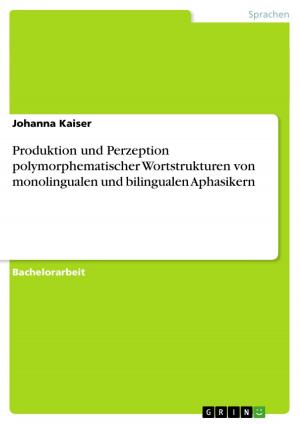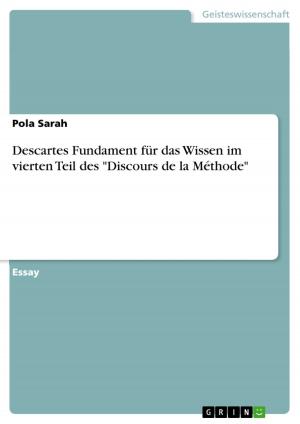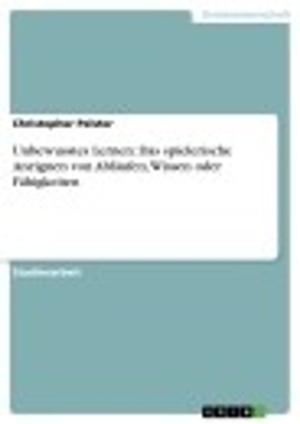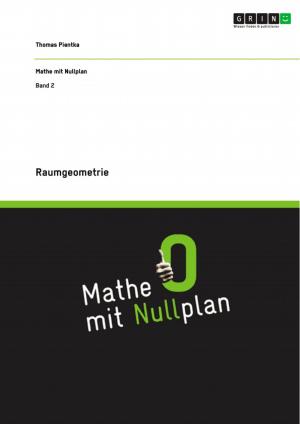Is He a Monster? - Caliban in William Shakespeare's 'The Tempest'
Caliban in William Shakespeare's 'The Tempest'
Fiction & Literature, Literary Theory & Criticism, British| Author: | Sandra Graf | ISBN: | 9783638348805 |
| Publisher: | GRIN Verlag | Publication: | February 11, 2005 |
| Imprint: | GRIN Verlag | Language: | English |
| Author: | Sandra Graf |
| ISBN: | 9783638348805 |
| Publisher: | GRIN Verlag |
| Publication: | February 11, 2005 |
| Imprint: | GRIN Verlag |
| Language: | English |
Seminar paper from the year 2004 in the subject English Language and Literature Studies - Literature, grade: 1,5, University of Tubingen (Englisches Seminar), course: Proseminar II Literatur: The World and Shakespeare, 11 entries in the bibliography, language: English, abstract: 'A salvage and deformed slave.' With these words William Shakespeare describes the figure of Caliban in the dramatis personæ of his play The Tempest. For almost four centuries, literary critics have dealt with trying to answer the question how Shakespeare's character has to be regarded. Is Caliban to be considered as a monster representing humanity's bestial side including all its vices, and thereby arousing the audience's disgust? Or has he rather to be looked at the victim of an imperia l tyrant - personified in Prospero - who arouses the spectator's pity? In which way Shakespeare really intended Caliban to be was, is and will ever be a secret he took to his grave. However, the reception history of the play has proven that Shakespeare's presentation of the characters - especially Caliban - opened up a large scope for various, often contradicting interpretations of the 'slave.' Thus, the following paper analyses the play with regard to the basic question whether or not Caliban is a monster. It is divided into two parts. The first one concentrates only on how Shakespeare's drama The Tempest in general and the character of Caliban in particular have been staged and interpreted throughout the last barely four centuries of reception. For this purpose, a small selection of representations of the play on stage and in editions are introduced and discussed, which show the major strands and general tendencies of Caliban's changing interpretations in the course of time. One of the main changes in Caliban's interpretation is the difference of reading the character in colonial and in post-colonial eras. After the end of the Second World War and after most of the world's colonies had been released and gained their independence, Caliban's role within the play and the interpretation of the whole, changed considerably. Thus, my analysis puts special emphasis on the contrast of colonial and post-colonial reading of the play. The second part concentrates only on Shakespeare's Caliban, that is, by a closer look on the bare material Shakespeare left us, an analysis of how Shakespeare intended his character to be. Of course this can and therefore will only be speculative, as Shakespeare obviously never stated his intention during his lifetime. In this part, it is mainly discussed which passages in the play suggest that Shakespeare indeed created a monster or whether the contrary is true that Caliban is rather a victim. [...]
Seminar paper from the year 2004 in the subject English Language and Literature Studies - Literature, grade: 1,5, University of Tubingen (Englisches Seminar), course: Proseminar II Literatur: The World and Shakespeare, 11 entries in the bibliography, language: English, abstract: 'A salvage and deformed slave.' With these words William Shakespeare describes the figure of Caliban in the dramatis personæ of his play The Tempest. For almost four centuries, literary critics have dealt with trying to answer the question how Shakespeare's character has to be regarded. Is Caliban to be considered as a monster representing humanity's bestial side including all its vices, and thereby arousing the audience's disgust? Or has he rather to be looked at the victim of an imperia l tyrant - personified in Prospero - who arouses the spectator's pity? In which way Shakespeare really intended Caliban to be was, is and will ever be a secret he took to his grave. However, the reception history of the play has proven that Shakespeare's presentation of the characters - especially Caliban - opened up a large scope for various, often contradicting interpretations of the 'slave.' Thus, the following paper analyses the play with regard to the basic question whether or not Caliban is a monster. It is divided into two parts. The first one concentrates only on how Shakespeare's drama The Tempest in general and the character of Caliban in particular have been staged and interpreted throughout the last barely four centuries of reception. For this purpose, a small selection of representations of the play on stage and in editions are introduced and discussed, which show the major strands and general tendencies of Caliban's changing interpretations in the course of time. One of the main changes in Caliban's interpretation is the difference of reading the character in colonial and in post-colonial eras. After the end of the Second World War and after most of the world's colonies had been released and gained their independence, Caliban's role within the play and the interpretation of the whole, changed considerably. Thus, my analysis puts special emphasis on the contrast of colonial and post-colonial reading of the play. The second part concentrates only on Shakespeare's Caliban, that is, by a closer look on the bare material Shakespeare left us, an analysis of how Shakespeare intended his character to be. Of course this can and therefore will only be speculative, as Shakespeare obviously never stated his intention during his lifetime. In this part, it is mainly discussed which passages in the play suggest that Shakespeare indeed created a monster or whether the contrary is true that Caliban is rather a victim. [...]















